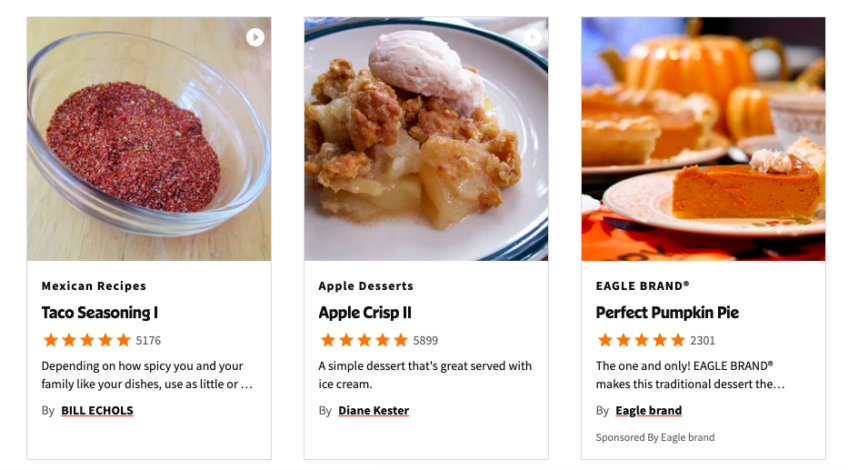Native programmatic advertising is an effective way for your brand to capture attention and build relevance. By definition, native advertising refers to content in an online publication that appears similar to the publication’s main content, but is paid for by an advertiser. The goal is ultimately to promote the advertiser’s products or services, without blatantly showing a banner advertisement for that product or service. The key to success is to fit your content seamlessly in the environment it appears in, without disrupting the user experience, and instead, adding value to it.
It sounds simple enough, but how do we make that happen? The following guide offers some best practices to help marketers create and implement successful native programmatic advertising campaigns to build their brand and reach the people who matter most.
What Is Native Advertising?
First, let’s start with the basics. As noted above, native advertising refers to content provided by an advertiser that appears in an online publication and resembles the publication’s editorial content
So, rather than buying a banner ad targeting a specific audience that might be interested in buying your products or services, the native “ad” comes in a different format – content – that is supposed to appear naturally in a particular publication. Native ads match the look and feel of the publication in which they appear, so they look like just another editorial piece in that channel.
The goal is to push a user to a strong piece of content that will capture his or her attention. For that reason, native is useful for prospecting and promoting content. Rather than driving your audience to a product page with a sales pitch, engaging your audience has the potential to drive longer-term positive results.
Native programmatic ads offer many of the same benefits as traditional programmatic advertising — automated media buying, effective targeting, and audience insights to improve future optimization.
Combining the power of programmatic with the long-term benefits of native, you can extend your reach and offer value and insights to a larger pool of potential customers. You get the speed and reach of programmatic with the marketing power of native.
Types of Native Ads
There are nearly as many different types of native ads out there as there are kinds of online content. Some of the types of programmatic native ads you may encounter or want to use as part of your campaigns are:
In-Feed
In-feed native ads show up in the publisher’s feed alongside their usual content and match the look, feel, and for the most part, the function of the regular content. They could take the form of articles, videos, infographics, or any other type of content the publisher usually creates. This content may be created in collaboration with the publisher, or the advertiser could create it on their own. Users might also interact with it right on the publisher’s site, or it could link away to the site of the company that created the ad.

Search
Native search ads typically appear at the top of search engine results pages. They look similar to organic search results but with some sort of indication that they’re paid. They feature small amounts of text and a link and may also include images and other features. They also function in the same way that organic search results do and take users to a particular webpage that, ideally, fulfills their search query.

Recommendations
Recommendations are sponsored pieces of content, such as articles and videos, that show up next to or underneath a publisher’s main content. Often, they are placed under a header that says something along the lines of “Recommended for you” or “You may also like…” They’re typically somewhat similar to the publisher’s main content but differ from it more than in-feed native ads. They may differ in style, format, or topic, and they take the user away from the publisher’s site if clicked on. Because of these features, they’re easier to identify as native ads.

Promoted Listings
Promoted listings are found on websites that don’t have editorial content, such as ecommerce sites. They typically advertise a product in a similar style as the regular listings on the ecommerce site and blend in with the rest of the product listings. You can find these native ads on sites like eBay, Amazon, and other sites where customers can purchase products.

In-Ad
This type of native advertisement looks like a typical ad but is relevant to the regular content on the page and may also contain other native elements. For example, a food brand might place an ad on a recipe site that links to recipes that use their product.

Examples of Native Advertising
Start browsing the web, and it probably won’t take long for you to run into some sort of native ad. Spending on native ads now accounts for about 63% of all U.S. display ad spending. While you probably see plenty of these ads in your day-to-day scrolling and surfing, here are a few stand-out native advertising examples.
Fast Company — Infographic: UPS’s 2012 Change in the (Supply) Chain Survey
Infographic-based native advertising can provide visual engagement and industry-relevant knowledge to your audience. This Fast Company infographic from UPS appeals to supply chain clients through original research about their market. It includes statistics on areas of growth and targets for improvement to help supply chain businesses understand how their companies compare. Most critically, it keeps its advertising low-key, putting the informative content front and center over the advertising content. Branded visuals and subtle calls-to-action direct the reader to the UPS website for more information.

Credible — Sponsored Content: 3 easy ways to get out of debt
Sponsored content is a great way to attract the attention of your target audience. It’s a piece of brand-sponsored content such as a blog post that lives on a media publisher’s website. In this example, Credible sponsored a piece of content “3 easy ways to get our of debt” that was published on foxbusiness.com. The key to sponsored content is to provide your target audience with some value – usually by educating or entertaining.
Best Practices for Native Programmatic Advertising
So, how can you make the most of your programmatic native advertising? Here are seven best practices to keep in mind when building out your native strategy.
1. Understand Your Consumers
As with any targeted marketing campaign, the first step is understanding your audience. Who are you trying to reach? What problems are they trying to solve, or what are they looking for? Learning more about their interests and needs allows you to create content that is relevant and helpful to them. The last thing you want is for your ad to be the one extraneous piece among a handful of others that are useful for the viewer.
2. Target for Content
No matter how compelling, your ad will be ineffective if it’s not in front of the right eyes. However, because of the nature of native advertising, content targeting is almost more critical than audience targeting here. You need to make sure that the content you are showing matches the type of content in its environment.
That being said, it’s also important to make sure your ad appears in brand-safe environments. Quality ad placements are more likely to be viewed in a positive light if they’re surrounded by other quality content. On the other hand, if your ad appears next to questionable content, your brand is likely to be viewed negatively as well.
3. Consider Intent
Another critical factor to consider when creating native ads is the users’ intent. To be truly native, your ad needs to match this intent and not interrupt the users’ experience. For example, if someone visits a YouTube channel that posts funny videos, their intent is to be entertained and have a laugh. That’s what the channel’s videos provide for them. Your native video ad needs to provide this too. If someone searches “buy shoes online” on Google, their intent is likely to purchase shoes using whatever device they’re on. Your paid search result should help them buy shoes online, rather than tell them about the history of shoes or give them fashion advice. A paid search result that doesn’t give the user the information they searched for isn’t likely to get clicked.
4. Aim to Add Value
Native ads don’t work if you are going for the hard sell. Instead, aim to add insight and encourage interactivity in the industry. Share best practices, offer advice, and tell stories with native ads. Building credibility by adding value to the consumer will pay off in the long run.
5. Create Compelling Creatives
When designing native advertising, don’t forget to focus on the creative. Your creative should be compelling and match the style of the content that surrounds it. Here are some best practices for creating native ads in various mediums.
- Articles: When creating sponsored articles, make sure the copy, including the title, matches the style of the publication you’re working with. Also, consider whether the publisher typically includes images or multimedia components in their stories. The topic should mesh well with the subjects the publication usually covers, and it should provide a similar type of value to the audience, whether that’s interesting information, humor, or helpful tips.
- Video: As with articles, the topic and style of your video should be similar to that of the videos the publisher usually creates. Consider whether their videos fit into a specific genre, such as documentary, animation, or sketch comedy. If they have a particular style, try to make your video’s style similar. Be sure that the quality and look of your video matches theirs as well. It might be helpful to work with the publisher on this. Also, don’t forget to spend some time on your video’s title!
- Audio: If you want to create a native ad for podcasts, music streaming services, or other audio-based media, focus on making your ad feel more like a piece of bonus content than an advertisement. Again, matching the style of the publisher you’re working with can help. For instance, if you’re creating an ad to put on a podcast about current events that has a serious tone, your ad should have a serious tone as well. If your brand is more light-hearted, a humor-focused podcast may be a better fit.
- Search: When creating native search ads, user intent is especially important. Try to ensure that your ad helps the user accomplish what they wanted to achieve by using the search engine. Also, make sure that all of the necessary information will show up in the search results and be easy for the user to read.
- Social: The best practices for native social ads differ somewhat depending on what social platform you’re placing your ad on. Your ad should match the style of the rest of the posts on the site and provide users with the same kind of value they were looking for when they opened up the app. For example, Twitter is ideal for short bits of text or images. LinkedIn is excellent for business- or industry-focused content. If you’re posting on Instagram, your ad should have an aesthetically pleasing, attention-grabbing visual.
6. Combine Native With Other Channels
Native advertising is one important part of a holistic marketing plan, but it can’t live in a silo. The content and tone of your native advertising may be slightly different from your other marketing messages, but they should all be working together with your cross-channel marketing plans in display, mobile, search, and social.
7. Experiment to See What Works Best
As you run your campaigns, don’t be afraid to experiment and make adjustments as needed to improve your results. With programmatic native ads, you’ll receive regular reports about how your ads are performing, which you can use to determine where you need to make changes. Try using A/B testing and other types of tests to see which versions of your ads perform best. You can also try starting with a broader audience and gradually narrow it down as you find out who engages most with your native advertising content. You can even try some outside-the-box experiments. You might stumble upon something great!
8. Draw Inspiration From Your Other Channels
When executing native advertising as part of a multi-channel campaign, feel free to use your other channels’ metrics and content to inspire your approach. If you see certain messages or creative outperforming others in your other channels, try integrating them into your native advertising. By viewing your advertising channels, including native, as part of a bigger whole, you’ll also promote more consistent messaging across channels and understand where native advertising should be on your priority list.
9. Leverage Geotargeting to Reach Local Customers
Tactics like geotargeting can work as well for native advertising as it does for advertising on other channels. Using geotargeting, you can deliver your ads to potential customers in the areas that use your product or service. The geotargeting process will look different depending on the type of native ad you display. For example, you can add a new layer to your geotargeting strategy by placing native advertising in online publications and stores tailored to a regional audience.
10. Implement Key Trends in the Digital Advertising Space
Advertising trends matter across channels, including in native programming. When developing native advertising, consider current consumer priorities and how a native format will meet them. In 2020, advertisers increased their focus on strong creative content and programmatic audio. To tap into these trends, you could prioritize visual native content or native podcast ads.
Content Marketing Reimagined
At AUDIENCEX, we leverage the power of programmatic native advertising to reimagine content marketing. With programmatic native, you can combine the efficiency of targeted and predictive messaging with an organic user experience. The benefits of this new approach to content marketing include:
- Contextual integration: Programmatic native advertising’s roots in content marketing will enable you to present ads as part of a larger engagement experience. Its format allows for more natural-feeling content than programmatic advertising alone.
- Powerful technology: With programmatic native advertising, you can tap into the feature-rich technology you use in programmatic advertising to target your exact audience. Our programmatic native solution serves ads on an impression-by-impression level and allows marketers to allocate their spend based on a wide range of parameters.
- Better user experience: Through the power of programmatic native advertising, you can speak to your customers on an individual basis instead of a group basis. Sharp audience targeting and organic presentation promote ad content that feels relevant and useful.
Master Native Advertising with AUDIENCEX
As the largest independent trading desk, tdX offers access to 24 DSPs, search, and social platforms to power high-performing campaigns for marketers and agencies across native, search, social, and display. Our proprietary platform grading system determines the best channel mix for your KPIs by assessing platforms on over 200 evaluation criteria, sorted by over 50 filters.

